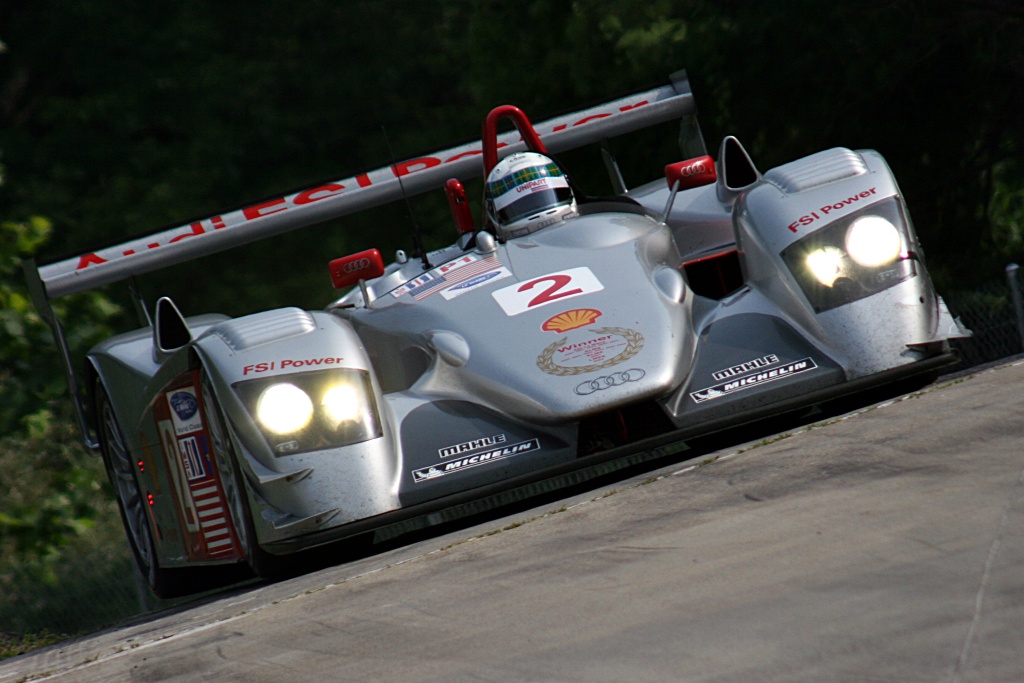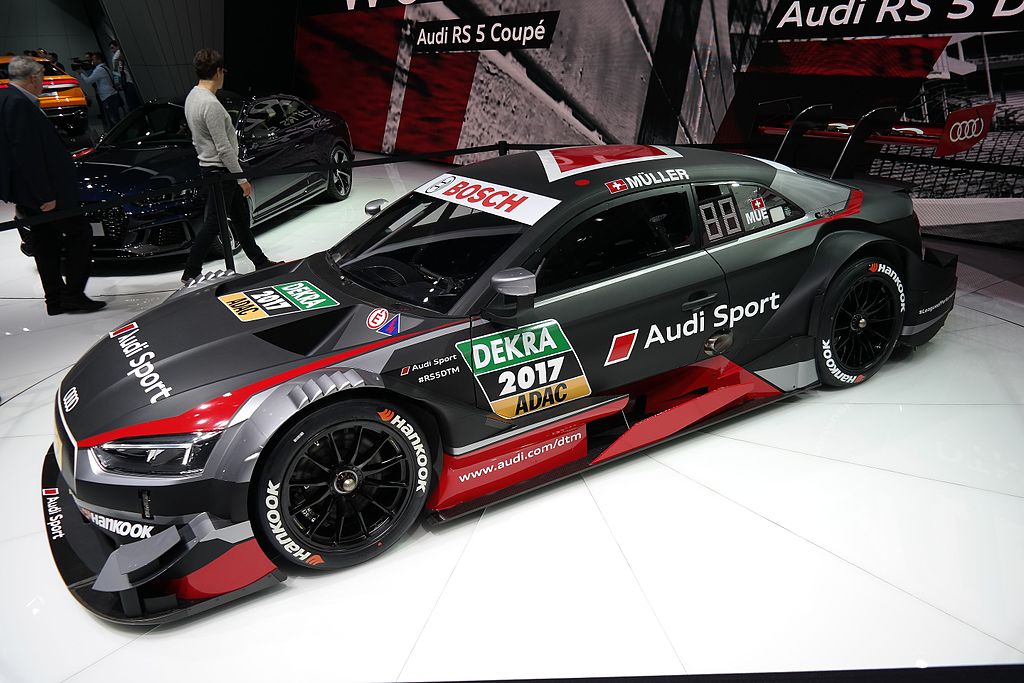Audi A4 DTM
The Audi A4 DTM is a 4-door touring car (DTM) constructed by the German car manufacturer Audi. It was first developed for use in the 2004 DTM season, replacing the Audi TT DTM at the end of the 2003 DTM season. Based on the Audi A4, it was continually improved over the course of six facelifts between 2004 and 2011. The Audi A4 DTM was succeeded by the Audi A5 DTM in 2012.To celebrate its first DTM championship title win in 2004, Audi released a production variant of the A4 called the DTM from 2005 to 2007. It featured an additional 20 horsepower over the standard model, sports-styled exterior features, and a new version of the quattro all-wheel-drive system.
Audi R8
The Audi R8 (Typ 42) is a mid-engine, 2-seater sports car, which uses Audi's trademark quattro permanent all-wheel drive system. It was introduced by the German car manufacturer Audi AG in 2006.
The car is exclusively designed, developed, and manufactured by Audi AG's private subsidiary company manufacturing high performance automotive parts, Audi Sport GmbH (formerly quattro GmbH), and is based on the Lamborghini Gallardo and presently the Lamborghini Huracán platform. The fundamental construction of the R8 is based on the Audi Space Frame, and uses an aluminium monocoque which is built using space frame principles. The car is built by quattro GmbH in a newly renovated factory at Audi's 'aluminium site' at Neckarsulm in Germany.
Audi R8 (LMP)
The Audi R8 is a Le Mans Prototype sports-prototype race car introduced in 2000 for sports car racing as a redevelopment of their Audi R8R (open top LMP) and Audi R8C (closed top LMGTP) used in 1999. In its class it is one of the most successful racing sports cars having won the 24 Hours of Le Mans race in 2000, 2001, 2002, 2004, and 2005, five of the six years it competed in total. Its streak of Le Mans victories between 2000 and 2005 was broken only in 2003 by the Bentley Speed 8 (another VAG brand).
The petrol-powered Audi R8 race car was in 2006 replaced by the new Audi R10 TDI Diesel; however, the need to further develop the R10 meant that the R8 saw action in a few races leading up to the 24 Hours of Le Mans.
Audi R8C
The Audi R8C is a Le Mans Prototype racecar that was built by Audi and designed by Peter Elleray to compete in the 1999 24 Hours of Le Mans under the LMGTP category. It was developed alongside the open Audi R8R LMP category spyder, prior to being replaced by the all-new Audi R8 in 2000.
Audi R8R
The Audi R8R was a Le Mans Prototype built by Audi for the 1999 24 Hours of Le Mans, and a predecessor to the dominant Audi R8 which debuted in 2000. It was raced alongside the British built closed-cockpit Audi R8C.
Audi R10 TDI
The Audi R10 TDI, usually abbreviated to R10, is a racing car from the German car manufacturer Audi. The car is a classic at Le Mans, winning every year since its introduction until it was replaced by the R15. It is designed and constructed for sports car racing in the Le Mans Prototype LMP1 class of the 24 Hours of Le Mans, and other similar endurance races. The car was unveiled 13 December 2005 at 12:00 CET, and went on to win both its maiden race at the 2006 12 Hours of Sebring in March, and the June 2006 24 Hours of Le Mans.
It was the first diesel-powered car to win either of those events. This is the most ambitious and the most expensive project ever undertaken by Audi Sport; the Audi R10 TDI project cost Audi $15 million a year.
Audi R15 TDI
The Audi R15 TDI, commonly abbreviated to the R15, is a Le Mans Prototype (LMP) racing car constructed by the German car manufacturer Audi AG. It is the successor to the Audi R10 TDI.
Like its predecessor, the R15 TDI uses a turbocharged diesel engine, although the R15's V10 engine is physically smaller than the R10's V12. The smaller engine is pushed further toward the middle of the car than in the R10, resulting in a more neutral weight balance that gives the car better agility around the corners than its predecessor.
Audi R18
Audi 5 Series DTM
The Audi 5 Series DTM (also known as the Audi A5 DTM (2012) later Audi RS5 DTM (2013-present)) is a DTM touring car constructed by the German car manufacturer Audi AG. It was developed in 2011 and has been raced in DTM seasons 2012-present. It was designed by former Audi Head of Research and Development Wolfgang Dürheimer. The A5 DTM replaced the retired Audi A4 DTM at the end of the 2011 season and based on the production Audi A5
Audi R18
The Audi R18 is a Le Mans Prototype (LMP) racing car constructed by the German car manufacturer Audi AG. It is the successor to the Audi R15 TDI. Like its predecessor, the R18 uses a TDI turbocharged diesel engine but with a reduced capacity of 3.7 litres and in a V6 configuration. For the first time since the 1999 R8C, Audi's Le Mans prototype uses a closed cockpit design. The R18 is also the first racing car from Audi to feature hybrid power.
Although Audi have previously given each new developed model of endurance racing car a distinct model number the head of Audi Sport, Wolfgang Ullrich, suggests the R18 designation for Audi endurance racing cars could be used for the foreseeable future as a result of rival car manufacturer Renault already holding trademarks for car model names R19 through to R35. There have been five further evolutions of R18 since the original spec introduced in 2011, the latest is the 2016 spec which competed in the 2016 World Endurance Championship.
Audi Quattro
The Audi Quattro is a road and rally car, produced by the German automobile manufacturer Audi, part of the Volkswagen Group. It was first shown at the 1980 Geneva Motor Show on 3 March.Production of the original version continued through 1991.
Audi TT
The Audi TT is a small 2-door sports car marketed by Volkswagen Group subsidiary Audi since 1998. It is assembled by the Audi subsidiary Audi Hungaria Motor Kft. in Győr, Hungary, using bodyshells manufactured and painted at Audi's Ingolstadt plant for the first two generations and parts made entirely by the Hungarian factory for the third generation.
For each of its three generations, the TT has been available as a 2+2 Coupé and as a two-seater roadster employing consecutive generations of the Volkswagen Group A platform, starting with the A4 (PQ34). As a result of this platform-sharing, the Audi TT has identical powertrain and suspension layouts as its related platform-mates; including a front-mounted transversely oriented engine, front-wheel drive or quattro four-wheel drive system, and fully independent front suspension using MacPherson struts.



.jpg/1024px-2005_DTM_Zandvoort_(16566809783).jpg)



_(cropped).jpg/1280px-Audi_R8_-_Flickr_-_Alexandre_Pr%C3%A9vot_(160)_(cropped).jpg)
_(cropped).jpg/1280px-Audi_R8_V10_-_Flickr_-_Alexandre_Pr%C3%A9vot_(2)_(cropped).jpg)
_(cropped).jpg/1920px-Audi_R8_V10_Spyder_-_Flickr_-_Alexandre_Pr%C3%A9vot_(6)_(cropped).jpg)










%2C_Audi_RS5_DTM_(9262680363).jpg/1024px-DTM_Brands_Hatch_2013_-_-12_Jamie_Green_(GBR)%2C_Audi_RS5_DTM_(9262680363).jpg)


.jpg/800px-Terenure%2C_Co._Dublin_-_Ireland_(6017584315).jpg)


_%E2%80%93_Frontansicht%2C_3._April_2015%2C_D%C3%BCsseldorf.jpg/1280px-Audi_TT_Coup%C3%A9_2.0_TFSI_quattro_S-line_(8S)_%E2%80%93_Frontansicht%2C_3._April_2015%2C_D%C3%BCsseldorf.jpg)

_1.8_T_coupe_(2011-11-08)_02.jpg/1280px-2003-2006_Audi_TT_(8N)_1.8_T_coupe_(2011-11-08)_02.jpg)













adafFfirno Marisol Soler https://marketplace.visualstudio.com/items?itemName=9globineemra.Descargar-Party-Of-Sin-gratuita
ReplyDeletebeltygeve